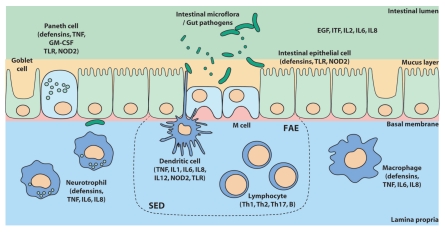Figure 1.
Most important mechanisms of defence in the intestinal epithelial barrier. Invasion of the mucosa is prevented by physical defences (mucus layer secreted by goblet cells, cellular barrier formed by epithelial cells) and by epithelial immune cells (Paneth cells and M cells). Recognition of pathogenic bacterial components is performed via TLR and NOD receptors. The inflammatory reaction involves mucosal immune system activation (mononuclear cells, lymphocytes and dendritic cells of the subepithelial dome). Inflammation is mediated by cytokines (TNF, IL) secreted by these different immune cells. EGF, epithelial growth factor; GM-CSF, granulocyte macrophage-colony stimulating factor; FAE, follicle-associated epithelium; ITF, intestinal trefoil factor; IL, interleukin; NOD2, nucleotide oligomerization domain 2; SED, subepithelial dome of the Peyer patch; Th, T helper lymphocyte; TLR, toll-like receptor; TNF, tumor necrosis factor. Source: Med Sci (Paris) 2010; 26:405–10.

